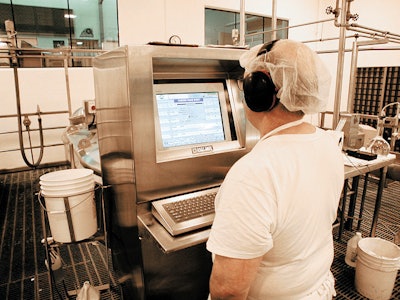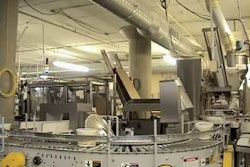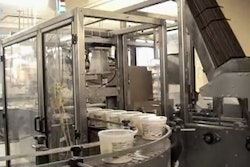When you’ve been making quality cheese and other dairy products for more than a hundred years, you don’t want to ruin the entire franchise with a botched product recall. That’s what managers at the Tillamook County Creamery Association had on their minds recently, when they decided to replace their paper-based tracking system with a modern computer-based system.
Peter McIntosh, a Canadian cheesemaker, and T.S. Townsend, a local butter maker, established the first commercial cheese factory in Tillamook County, OR, in 1894. Actually, they built the factory on work begun in 1854 when several area farmers banded together to build a two-masted schooner to transport butter to Portland. A picture of the ship remains on Tillamook product labels. And McIntosh’s recipe for cheese is also still used.
Beginning with a cooperative of ten operating cheese factories in 1909, the Tillamook County Creamery Association was formed to control cheese quality. By 1968 all cheese factories in the county became part of the farmer-owned cooperative. Today the 150-member association employs more than 470 and produces eight varieties of Cheddar cheese, along with several other cheeses, butter, ice cream, sour cream, yogurt, fluid milk and dried whey.
As management looked for a computer-based tracking system to replace its paper-based version, maintaining top product quality was a high priority. “We were looking for a process control and monitoring system that would both document our process and allow us to look into that process from any point in the plant,” says James McMullen, senior vice president and chief operating officer. “We sought a good operator interface system that could give us a single view into any of the multiple process steps we use, and we wanted a statistical process control (SPC) package that would allow operators to maintain tight control over the cheese-making process.”
Not being shy about requirements for a new system, McMullen adds, “We also wanted better inventory control so that we could track the process throughout the plant and document it on a real-time basis. In addition, we wanted complete traceability of product ingredients and genealogy of all finished products. The work-in-process (WIP) tracking system had to be able to seamlessly handle both batch tracking of bulk product and discrete tracking of individual packaged goods. We felt we needed this high level of capability because, although we had never had to do a product recall, one of our primary goals was to create a system whereby we could handle any potential recall in a prompt and efficient manner.”
Performance means quality
Tillamook turned to an Albany, OR-based systems integrator that specializes in implementation of software systems based on products from Wonderware, a Lake Forest, CA, business unit of London-based Invensys. Senior Systems Engineer Jeff Baxter, of Progressive Software Solutions, recalls that Tillamook’s first concern was the ability to handle potential product recalls. “They really measure performance in terms of quality at Tillamook,” Baxter observes.
In pitching a product-tracking solution that could handle the recall situation, Progressive proposed starting with the packaging area. In the hard cheese process, milk goes through a bacteriology process in a machine that Tillamook calls the “Cheddarmaster,” and comes out as a 40-pound block. “We started tracking when the block of cheese was ‘put through the wall’ from the manufacturing process room to the aging room. A bar code label was applied in order to track the block through the aging process and on into finished goods packaging,” says Baxter.
The system was designed from the beginning to allow for expansion. Baxter reports implementation was straightforward, with training on the new systems following the typical learning curve. Not long after implementation of the cheese block tracking part of the project, Tillamook began to see direct value, through improved stability of its inventory levels—both WIP and raw materials. Prior to the system’s launch, inventory levels “fluctuated significantly,” says Baxter. The improved stability improved planning.
The block of cheese is aged from 60 days to two years, depending upon grade. During aging, and then again through the packaging process, each block must be tracked. The system tracks where a block is physically, as well as its grade and status during the aging process. The system not only tracks inventory from raw milk to the sales order, but it can even tell approximately which farm the milk came from and to which store it was shipped.
As the system expanded from the CheddarMaster room to the entire process, manufacturing management discovered that they had sufficient information to be able to reproduce the highest quality cheese—a benefit that also enhanced the company’s gross margins.
The company realized its main benefit, as well. In the event of a product problem necessitating a recall, managers can pinpoint the step in the process that caused the fault, and move rapidly to mobilize resources to lessen the impact. Baxter reports that the engineering manager told him that just the automation of the cheese starter room paid huge benefits with the consistent production and higher quality.
“We exclusively use Wonderware products,” states Progressive’s Baxter. “This system uses InTrack for WIP tracking and product genealogy, InTouch for plant human-machine interface, Industrial SQL Server for history, and Active Factory for visualization of historical data.”
Transparent tracking comes to the kibbutz
In a situation similar to Tillamook cheese, Pri-Psagot, located in Kibbutz Yaron, Israel, is the second largest packing house in the country. The company has a challenging problem. Farmers from the kibbutz send their fruit to Pri-Psagot for processing and packaging. However, the farmers are not paid until their fruit reaches the retail floor. Every farmer’s fruit must be traced throughout the processing and packaging system all the way to the retailer. Not only that, the tracking must be transparent and open, so that each farmer can check to see the status of his or her product.
Pisga, a systems integrator specializing in the Xfactory product from Tecnomatix UGS, located in Carmiel, Israel, came to the rescue. Ori Rayvitz, Pisga chief technology officer, describes the Xfactory functions used in the solution. “We get the manufacturing execution system with all its basic functions from Xfactory,” he states, “plus the platform for us to build the application on, genealogy, tracking and reporting. We can take this base and build a different flavor for each industry we serve.”
Hertzel Ben Zion, Pisga chief executive officer, describes the system from picker to retailer. “Before the pickers even go to the orchard, they tell the system what they’ll be picking. There’s a barcode label on the container. They read the barcode with a handheld device equipped with radio telemetry, and the product and container number are logged at the packing house.”
When the fruit arrives at the packing house, it goes through a preliminary sorting process on an automated machine equipped with a vision system. The fruit is still tracked by container number tied to the farm of origin.
Keep them frozen
Picking season in Israel lasts from August to October. At that point, the packing house must use long-term freezing to keep the fruit until it can be processed and packed for shipment to stores. The freezing process is critical to the eventual quality of the product. So the Pisga system collects information from the freezer. The system tracks such variables as temperature and humidity.
The next process for the fruit is a secondary sorting. Done manually, this sorting slots fruit for the type of packaging required. The packaging system requires information about type of fruit, type of process spices required and type of packaging material. Some retailers have specific cartoning requirements, while others will accept a more generic carton. After packaging and cartoning, the system not only needs to know the source of the fruit in each box, it also needs to know where each box is on a pallet. Because the farmers are not paid until the produce is sold, everything is traceable from the store shelf to the farm where it was picked. The system also had to be able to handle changes in the system easily. It also sends a short message service (SMS) to the farmer over a mobile phone to tell him when his fruit is being sorted, so that he can watch the process. The system has Web-based visibility so that a farmer can see everything she needs to know about the status of her fruit.
Pisga’s Rayvitz says that his company had to put together a team consisting of members from the farmers, packing house, retailer and integrator to design and implement the system. The system includes a virtual private network, wireless communications, and personal digital assistants. The eight-month project included two months for training.
No longer can a packaging department stand alone in a manufacturing environment. Tight coupling of information from the beginning of the process through the packaging of the product to the final element of the supply chain is not a luxury, but a necessity in today’s environment.



























